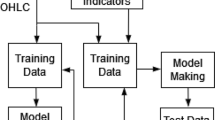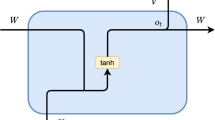Abstract
Recently, a substantial body of literature in finance has implemented deep learning algorithms as predicting approaches. The principal merit of these methods is the ability to approximate any nonlinear and linear behaviors without understanding the data generation process, making them suitable for predicting stock market movement. This paper explores deep learning approaches to forecast stock price movement in the Hong Kong stock market. The forecasting performance of a temporal convolutional network (TCN) approach and several recurrent neural network (RNN) models is compared. The results show that the TCN can outperform all compared RNN models. Further parameter tuning results also show the superiority of the TCN approach. In addition, we demonstrate that a profitable strategy can be built based on the forecasting results of the proposed model.












Similar content being viewed by others
References
Abu-Mostafa, Y. S., & Atiya, A. F. (1996). Introduction to financial forecasting. Applied Intelligence, 6(3), 205–213.
Alhashel, B. S., Almudhaf, F. W., & Hansz, J. A. (2018). Can technical analysis generate superior returns in securitized property markets? Evidence from east Asia markets. Pacific-Basin Finance Journal, 47, 92–108.
Appel, G. (1979). The moving average convergence divergence trading method (150 Great Neck Rd, Great Neck, NY 11021: Signalert Corp).
Bai, S., Kolter, J. Z., & Koltun, V. (2018). An empirical evaluation of generic convolutional and recurrent networks for sequence modeling. Universal language model fine-tuning for text classification, pp. 30–44.
Barbaglia, L., Manzan, S., & Tosetti, E. (2021). Forecasting loan default in europe with machine learning. Journal of Financial Econometrics pp. 1–28.
Bucci, A. (2020). Realized volatility forecasting with neural networks. Journal of Financial Econometrics, 18(3), 502–531.
Cho, K., Van Merriënboer, B., & Bahdanau, D. (2014). On the properties of neural machine translation: Encoder-decoder approaches. Proceedings of SSST 2014—8th workshop on syntax, semantics and structure in statistical translation, pp. 103–111.
Chung, J., Gulcehre, C., Cho, K., & Bengio, Y. (2014). Empirical evaluation of gated recurrent neural networks on sequence modeling. arXiv:1412.3555.
Creamer, G. (2012). Model calibration and automated trading agent for euro futures. Quantitative Finance, 12(4), 531–545.
Edwards, R. D., Magee, J., & Bassetti, W. (2018). Technical analysis of stock trends. CRC Press.
Elend, L., Tideman, S. A., Lopatta, K., & Kramer, O. (2020). Earnings prediction with deep leaning. KI 2020: Advances in artificial intelligence, pp. 267–274. Cham: Springer International Publishing.
Erel, I., Stern, L. H., Tan, C., & Weisbach, M. S. (2021). Selecting directors using machine learning. The Review of Financial Studies, 34(7), 3226–3264.
Goel, K., Vohra, R., & Sahoo, J. K. (2014). Polyphonic music generation by modeling temporal dependencies using a rnn-dbn. In International conference on artificial neural networks, pp. 217–224.
He, K., Zhang, X., Ren, S., & Sun, J. (2016). Deep residual learning for image recognition. Proceedings of the IEEE conference on computer vision and pattern recognition, pp. 770–778.
Heaton, J. B., Polson, N. G., & Witte, J. H. (2017). Deep learning for finance: Deep portfolios. Applied Stochastic Models in Business and Industry, 33(1), 3–12.
Hochreiter, S., & Schmidhuber, J. (1997). Long short-term memory. Neural Computation, 9(8), 1735–1780.
Huang, C. L., & Tsai, C. Y. (2009). A hybrid SOFM-SVR with a filter-based feature selection for stock market forecasting. Expert Systems with Applications, 36(2), 1529–1539.
Kara, Y., Boyacioglu, M. A., & Baykan, Ö. K. (2011). Predicting direction of stock price index movement using artificial neural networks and support vector machines: The sample of the istanbul stock exchange. Expert systems with Applications, 38(5), 5311–5319.
Koo, E., & Kim, G. (2023). A new neural network approach for predicting the volatility of stock market. Computational Economics, 61, 1665–1679.
Lea, C., Flynn, M. D., Vidal, R., Reiter, A., & Hager, G. D. (2017). Temporal convolutional networks for action segmentation and detection. In Proceedings of the IEEE conference on computer vision and pattern recognition, pp. 156–165.
LeCun, Y., Bengio, Y., & Hinton, G. (2015). Deep learning. Nature, 521(7553), 436–444.
Leippold, M., Wang, Q., & Zhou, W. (2022). Machine learning in the Chinese stock market. Journal of Financial Economics, 145(2), 64–82.
Liu, Y., Dong, H., Wang, X., & Han, S. (2019). Time series prediction based on temporal convolutional network. 2019 IEEE/ACIS 18th International conference on computer and information science (ICIS), pp. 300–305.
Novak, M. G., & Velušček, D. (2016). Prediction of stock price movement based on daily high prices. Quantitative Finance, 16(5), 793–826.
Persio, L. D., & Honchar, O. (2017). Recurrent neural networks approach to the financial forecast of google assets. International Journal of Mathematics and Computers in Simulation, 11, 7–13.
Sen, J., & Mehtab, S. (2021). Accurate stock price forecasting using robust and optimized deep learning models. International Conference on Intelligent Technologies (CONIT), 2021, 1–9.
Shen, T., Zhou, T., Long, G., Jiang, J., Pan, S., & Zhang, C. (2018). Disan: Directional self-attention network for RNN/CNN-free language understanding. Proceedings of the AAAI conference on artificial intelligence vol 32, no. 1
Tan, T. Z., Quek, C., & Ng, G. S. (2007). Biological brain-inspired genetic complementary learning for stock market and bank failure prediction. Computational Intelligence, 23(2), 236–261.
Thawornwong, S., Enke, D., & Dagli, C. (2003). Neural networks as a decision maker for stock trading: A technical analysis approach. International Journal of Smart Engineering System Design, 5(4), 313–325.
Ticknor, J. L. (2013). A Bayesian regularized artificial neural network for stock market forecasting. Expert Systems with Applications, 40(14), 5501–5506.
Vijh, M., Chandola, D., Tikkiwal, V. A., & Kumar, A. (2020). Stock closing price prediction using machine learning techniques. Procedia Computer Science, 167, 599–606.
Weng, B., Ahmed, M. A., & Megahed, F. M. (2017). Stock market one-day ahead movement prediction using disparate data sources. Expert Systems with Applications, 79, 153–163.
Wiese, M., Knobloch, R., Korn, R., & Kretschmer, P. (2020). Quant gans: Deep generation of financial time series. Quantitative Finance, 20(9), 1419–1440.
Wilder, J. (1978). New concepts in technical trading systems.
Yao, H., Xia, S., & Liu, H. (2022). Six-factor asset pricing and portfolio investment via deep learning: Evidence from Chinese stock market. Pacific-Basin Finance Journal, 76, 101886.
Yu, F., & Koltun, V. (2016). Multi-scale context aggregation by dilated convolutions. International Conference on Learning Representations (ICLR), 2016, 1–13.
Yule, G. U. (1909). The applications of the method of correlation to social and economic statistics. Journal of the Royal Statistical Society, 72(4), 721–730.
Funding
The authors gratefully acknowledge financial support from the Humanities and Social Sciences Fund of Ministry of Education (22YJAZH007, 23YJAZH037), Huazhong University of Science and Technology Double First-Class Funds for Humanities and Social Sciences. The computation is completed in the HPC Platform of Huazhong University of Science and Technology.
Author information
Authors and Affiliations
Corresponding author
Ethics declarations
Declarations of Interest
No potential conflict of interest is reported by the authors.
Additional information
Publisher's Note
Springer Nature remains neutral with regard to jurisdictional claims in published maps and institutional affiliations.
Rights and permissions
Springer Nature or its licensor (e.g. a society or other partner) holds exclusive rights to this article under a publishing agreement with the author(s) or other rightsholder(s); author self-archiving of the accepted manuscript version of this article is solely governed by the terms of such publishing agreement and applicable law.
About this article
Cite this article
Chen, S., Guo, L. & Ge, L. Increasing the Hong Kong Stock Market Predictability: A Temporal Convolutional Network Approach. Comput Econ (2024). https://doi.org/10.1007/s10614-024-10547-y
Accepted:
Published:
DOI: https://doi.org/10.1007/s10614-024-10547-y




